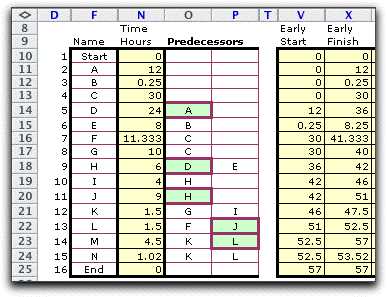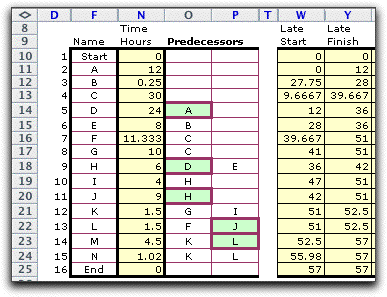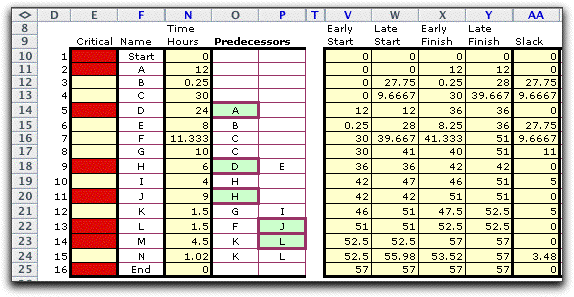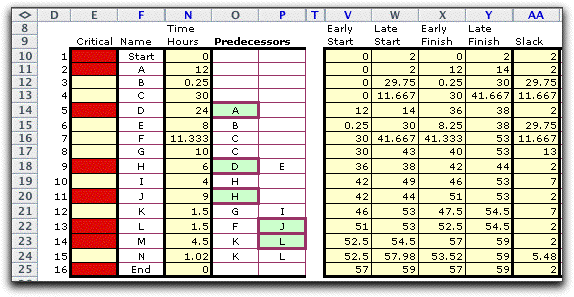|
|
|
|
Project
Management
|

|
-
Critical Path Analysis |
| |
 |
Critical
path analysis is performed by solving a simple set of equations.
The purpose is to find bounds on the start and finish time of
each activity. Here we use the activity-on-node model, and in
the following we use the term node rather than activity. The
equations assume that the nodes are indexed in precedence order.
That is, the index of each node is greater than any of its predecessors.
The equations use the notation below.
On the remainder of this page we derive and illustrate the
equations used for critical path analysis. |
Early Start |
 |
The early start time
for a node is based on the logical requirement that a node can
begin only when all its predecessors have been completed.
Early Start Time = Latest(Finish
Time for all predecessors)
When we assume all predecessors finish as early as possible
then:
Early Start Time = Latest(Early
Finish Time for all predecessors)
Early Start Time = Max(Early Finish
Time for all predecessors)
The early finish time is the early start time
plus the activity time for the node.
We describe these relationships with mathematical notation
below. The project starts at time 0. The due date is T.
We compute the earliest start times and latest finish times
by first setting the earliest start node time for the Start
node to 0 and then solving the ES and EF equations
for each node in order of increasing node index. It is possible
to compute the earliest start time for a node because the earliest
finish times for all predecessor nodes have already been computed.
The earliest finish time for the End node is the earliest
finish time for the project. That must be no more than the due
date.
We illustrate the formulas using columns from the project worksheet.
We have hidden the columns that are not directly relevant to
this calculation. Recall that nodes that have no predecessors
shown on the table are immediately preceded by the Start
node. Nodes that have no successors shown in the table are immediate
predecessors to the End node.

Some of the steps of the process are shown in
the table. Nodes 9 and 16 involve two predecessors. Except for
the start node, the others have only one.
Node |
Name |
 |
 |
1 |
Start |
ES(1)=0 |
EF(1)=ES(1)+t(1)=0 |
2 |
A |
ES(2)=EF(1)=0 |
EF(2)=ES(2)+t(2)=12 |
3 |
B |
ES(3)=EF(1)=0 |
EF(3)=ES(3)+t(3)=0.25 |
4 |
C |
ES(4)=EF(1)=0 |
EF(4)=ES(4)+t(4)=30 |
5 |
D |
ES(5)=EF(2)=12 |
EF(5)=ES(5)+t(5)=36 |
6 |
E |
ES(6)=EF(3)=0.25 |
EF(6)=ES(6)+t(6)=8.25 |
7 |
F |
ES(7)=EF(4)=30 |
EF(7)=ES(7)+t(7)=41.333 |
8 |
G |
ES(8)=EF(4)=30 |
EF(8)=ES(8)+t(8)=40 |
9 |
H |
ES(9)=Max(EF(5),EF(6))
ES(9)=Max(36,8.25)=36 |
EF(9)=ES(9)+t(9)=42 |
... |
... |
|
|
16 |
End |
ES(16)=Max(EF(14),EF(15))
ES(16)=Max(57,53.52)=57 |
EF(16)=ES(16)+t(16)=57 |
|
Latest Finish |
| |
The latest finish time
for a node is based on the logical requirement that a node must
end before any of its successors may be begin.
Latest Finish Time = Earliest(Start
Time for all successors)
When we assume all successors start as late as possible then:
Latest Finish Time = Earliest(Latest
Start Time for all successors)
Latest Finish Time = Min(Latest
Start Time for all successors)
The latest start time is simply the latest finish
time less the activity time for the node.
We describe these relationships with mathematical
notation below.
The latest finish times and latest start times
are computed in the reverse order of the node indices. First
we set the latest finish time for the End node to the
due time for the project. This must be no less than the earliest
finish time for the project. The latest finish time for a node
must be the minimum of all the latest start times of all successor
nodes. We can compute the latest finish time for a node because
the latest start times for all successor nodes have already
been computed. We illustrate the formulas using columns from
the project worksheet. We have hidden the columns that are not
directly relevant to this calculation. Recall that although
the form does not show it, the End node has as predecessors
all nodes with no successors. In the example, the predecessors
of the End node are M and N. For the example, the due
date is the same as the early finish time, that is 57.

Some of the steps of the process are shown in
the table.
Node |
Name |
 |
 |
16 |
End |
LF(16)=57 |
LS(16)=LF(16)-t(16)=57 |
15 |
N |
LF(15)=LS(16)=57 |
LS(15)=LF(15)-t(15)=55.98 |
14 |
M |
LF(14)=LS(16)=57 |
LS(14)=LF(14)-t(14)=52.5 |
13 |
L |
LF(13)=Min(LS(14),LS(15))
LF(13)=Min(55.98,52.5)=52.5 |
LS(13)=LF(13)- t(13)=51 |
12 |
K |
LF(12)=Min(LS(14),LS(15))
LF(12)=Min(55.98,52.5)=52.5 |
LS(12)=LF(12)- t(12)=51 |
11 |
J |
LF(11)=LS(13)=51 |
LS(11)=LF(11)- t(11)=42 |
... |
... |
|
|
1 |
Start |
LF(1)=Min(LS(2),LS(3),LS(4))
LF(16)=Min(0,27.75,9.67)=0 |
LS(1)=LF(1)- t(1)=9 |
|
Slack Time |
| |
The slack
time is the difference between late and early start times.
The figure below shows the results shown previously
and column AA that computes the slack time for each node.

The slack value is the increase the amount of
time an activity can be delayed without delaying the completion
of the project. When the early start time and late start time
are equal, the activity cannot be delayed, so this activity
is said to be critical. Activities with positive slack are not
critical because they can be delayed without affecting the project
duration.
Column E shows the critical activity with a red
field, while non-critical activities have a yellow field. If
the due date were increased all the slack values would be increased
by the same amount. The example below shows the same table with
the due date set to 59.

Strictly speaking, none of the activities are
now critical with respect to the due date, because the minimum
slack value is 2. We define however a critical activity as one
that cannot be delayed without exceeding the earliest completion
time. With respect to the table, the critical activities are
those that have the minimum value of the slack times. The set
shown in column E is the same as when the due date is 57. |
Analysis with Excel Functions |
| |
Here we consider the
computation for early and late start and finish times entirely
with Excel formulas. This allows an immediate update of the
results when an activity time is changed. This method is used
for the Project Management add-in. The process is not
obvious because the formulas are recursive equations. Obvious
attempts to represent the equations with Excel result in circular
references. We explain the computations with reference to the
worksheet below. The difficulties come when constructing the
equations for ES in column V and LF in column Y.
In column V the add-in constructs explicit references to predecessors.
A formula computing the earliest start time for a node, solves
for the earliest start time by computing the maximum of the
earliest finish times of the predecessor nodes. For example
the formula in cell V18 computing the earliest start time of
node 9 is:
=MAX(X14,X15)
Cells X14 and X15 hold the earliest finish time
of nodes 5 and 6. These are the immediate predecessors of node
9. The add-in constructs these formulas from the activity data.
Further the early finish times are computed from the early start
times. For example the early finish time for node 9 in X18 is
computed as:
=V18+N18
Similarly formulas are constructed for the other
cells in columns V and X. Although column X depends on column
V and column V depends on column X, the formulas do not result
in a circular reference because the project network has no cycles.
No cell value depends on itself.
|

| |
Similar
formulas are used to calculate the late finish times in column
Y. For example the cell Y18 holds the late finish time for node
9. It is computed with the formula:
=MIN(W19,W20)
The latest start time for node 9 is the minimum
of the latest start times for immedediate successors of node
9, nodes 10 and 11. Entries in row W depend on row Y. For example,
cell W18 is computed with the formula:
=Y18-N18
Again, although column Y depends on column W,
and column W depends on column Y, the formulas do not result
in circular references because the project network has no cycles.
No cell value depends on itself.
Since references to successor and predecessor nodes are explicit
on the worksheet, the formulas are no longer valid after changes
to the numbers of activities or the precedence relationships.
Critical path analysis provides only bounds on the starting
and ending completion times. More detailed schedules are developed
when delays are included as described on the next page. |
|



